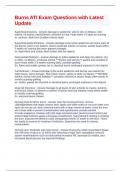Burns ATI Exam Questions with Latest
Update
Superficial thickness - Answer-damage to epidermis, pink to red, no blisters, mild
edema, no eschar, painful/tender, sensitive to heat, heals within 3-6 days no scarring
ex. sunburn, flash burn (sudden intense heat)
Superficial partial thickness - Answer-damage to the entire epidermis and some parts of
the dermis. pink to red, blisters, mild to moderate edema no eschar, painful heals within
3 weeks no scarring but minor pigment changes
ex. flash flame and scalds, brief contact with hot objects
Deep partial thickness - Answer-damage to entire epidermis and deep into dermis. red
to white, no blisters, moderate edema ***Eschar soft and dry**, painful and sensitive to
touch heals within 2-6 weeks scarring likely, possible grafting
Ex. flame and scalds, grease, tar or chemical burns, prolonged exposure to hot objects
Full thickness - Answer-Damage to the entire epidermis and dermis can extend into
subQ tissue, nerve damage. Red, black, brown, yellow or white no blisters ***SEVERE
edema, eschar hard and inelastic*** sensation minimal or absent heals within weeks to
months scarring grafting
ex. scalds, grease tar chemical or electrical burns, prolonged exposure to hot objects
Deep full thickness - Answer-Damage to all layers of skin extends to muscle, tendons,
and bones. Black, no blisters or edema **Eschar hard and inelastic heals within weeks
to months scarring grafting
Ex. electrical burns, flames
Nursing Care for Minor burns - Answer-stop the burning process: remove
clothing/jewelery that might conduct heat. apply cool water soaks or run cool water over
injury do not use ice. flush chemical burns with a large volume of water. cover the burn
wit a clean cloth to prevent contamination and hypothermia. provide warmth
Provide analgesics, cleanse with mild soap and tepid water (avoid excess friction) use
antimicrobial ointment apply a dressing (nonadherant, hypocolloid) if clothing is irritating
the burn. Educate the family to avoid using greasy lotions or butter on the burn. Teach
the family to ovserve for evidence of infection. Determine the need for tetanus
immunization.
Nursing care: Moderate and major burns - Answer-During the initial resuscitation phase
from the time of injury to 12-48hrs later following a major burn sympathetic nervous
system manifestations such as tachycardia increases RR, decrease GI motility, and
increased blood glucose are expected findings.
, Nursing care: moderate and major burns: CV system - Answer-presence of edema,
central and peripheral pulses cap. refill pulse ox invasive or noninvasive blood pressure
and EKG changes
Nursing care: moderate and major burns: Respiratory system - Answer-Assess RR and
depth, upper airway edema becomes pronounced 8-12hrs after the beginning of fluid
resuscitation. Crowing, stridor, or dyspnea requires nasal or oral intubation. Provide
humidified O2. Support airway and ventilation. Mechanical ventilation and paralytic
medications (atracurium or vecuronium) can be necessary. Provide care for
tracheotomy when long term intubation is expected. Monitor and maintain chest tubes,
instruct client to cough, deep breathe and use IS every hour. Suction every hour or as
needed. Consider the need for additional analgesics.
Nursing care: moderate and major burns: GI system - Answer-Clients at risk for
aspiration might need NG tube insertion. Some clients experience gastroparesis and
vomiting. Monitor stool, vomit, and gastric secretions for blood. keep HOB elevated at
all times
Nursing care: moderate and major burns: Urinary system - Answer-Insets foley, monitor
I&O, monitor urine characteristics specific gravity BUN creatinine and Na.
Nursing care: moderate and major burns: Fluid replacement: to maintain cardiac output
- Answer-Hypovolemic shock is a common cause of death in resuscitation phase. Starts
IV access using large bore needle if burns cover a large area of body client requires
CVC or IO catheter. fluid replacement is important during the first 24hrs. Third spacing
(capillary leak syndrome) is a continuous leak of plasma from the vascular space into
the interstitial space which results in electrolyte imbalance and hypotension. Rapid fluid
replacement during the emergent phase maintains tissue perfusion and prevents
hypovolemic shock. Fluid resuscitation meets individual clients needs (TBSA of burn,
burn depth, inhalation injury, associated injuries, age, urine output cardiac output blood
pressure status of electrolytes). administer half of the total 24hr IV fluid volume within
the first 8hr and the remaining volume over the next 16hr. Infuse isotonic crystalloid
solutions such as 0.9% NaCl, LR. Infuse colloid solutions such as albumin, or synthetic
plasma expanders after the first 24hr of burn recovery. Vital signs, assess for fluid
overload: edema, engorged neck veins, rapid and thready pulse lung crackles wheezes.
Daily weight, maintain urine output of 30ml/hr (o.5ml/kg/hr). Monitor for manifestations
of shock: alterations in sensorium (confusion), increased cap refill time, urine output
less than 30ml/hr, rapid elevations of temperature, decreased bowel sounds, blood
pressure average or low. Maintain thermoregulation.
Nursing care: moderate and major burns: Hypothermia - Answer-The skin helps control
the boys temperature. With skin injury, the body looses heat. Use warm, inspired air, a
warm room, warming blankets, and warmers for infusing fluids.




